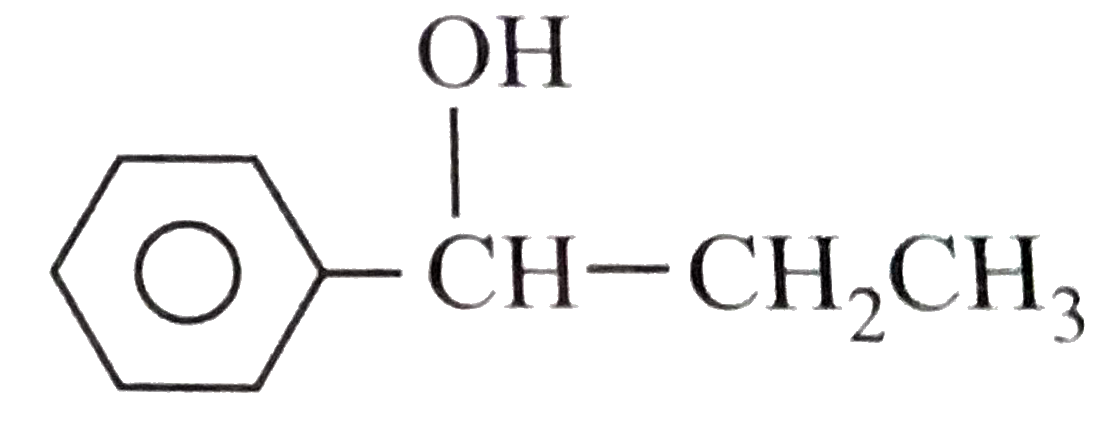In a set of the given reactions, acetic acid yielded a product iC.
CH3COOH+PCl5→AC6H6−−−−−−→Anh.AlCl3BC2H5MgBr−−−−−−→etherC
Product C would be
CH3CH(OH)C2H5
CH3COC6H5
CH3CH(OH)C6H5
CH3− C2H5∣C(OH)C6H5
The correct Answer is:D
To solve the problem step by step, we will analyze each reaction in the sequence provided and determine the final product C.
Step 1: Reaction of Acetic Acid with PCl5
- Reaction: CH3COOH+PCl5
- Explanation: When acetic acid (CH3COOH) reacts with phosphorus pentachloride (PCl5), the hydroxyl group (–OH) of the carboxylic acid is replaced by a chlorine atom (–Cl). This reaction converts acetic acid into acetyl chloride (CH3COCl).
- Product A: CH3COCl (acetyl chloride)
Step 2: Friedel-Crafts Acylation with Benzene
- Reaction: CH3COCl+C6H6 in presence of anhydrous AlCl3
- Explanation: The acetyl chloride (A) undergoes Friedel-Crafts acylation when reacted with benzene (C6H6) in the presence of anhydrous aluminum chloride (AlCl3). This results in the formation of a ketone. The chlorine atom acts as a good leaving group, allowing the acyl group (–C(O)CH3) to attach to the benzene ring.
- Product B: C6H5C(O)CH3 (acetophenone)
Step 3: Reaction with Grignard Reagent
- Reaction: C6H5C(O)CH3+C2H5MgBr in ether
- Explanation: The acetophenone (B) reacts with the Grignard reagent (C2H5MgBr). The nucleophilic ethyl group (C2H5) from the Grignard reagent attacks the carbonyl carbon of the ketone, forming a tertiary alcohol. The oxygen in the carbonyl group becomes negatively charged and is stabilized by the magnesium bromide.
- Intermediate: C6H5C(OH)(C2H5)CH3 (alkoxide intermediate)
Step 4: Protonation of the Alkoxide
- Protonation: The alkoxide intermediate is then protonated (usually by adding water or another proton source), resulting in the formation of the final alcohol product.
- Product C: C6H5C(OH)(C2H5)CH3 (a tertiary alcohol)
Final Product
- The final product C is a tertiary alcohol derived from the reaction of acetophenone with ethylmagnesium bromide.
Answer
Product C would be C6H5C(OH)(C2H5)CH3.
---
- Reaction: CH3COOH+PCl5
- Explanation: When acetic acid (CH3COOH) reacts with phosphorus pentachloride (PCl5), the hydroxyl group (–OH) of the carboxylic acid is replaced by a chlorine atom (–Cl). This reaction converts acetic acid into acetyl chloride (CH3COCl).
- Product A: CH3COCl (acetyl chloride)
- Reaction: CH3COCl+C6H6 in presence of anhydrous AlCl3
- Explanation: The acetyl chloride (A) undergoes Friedel-Crafts acylation when reacted with benzene (C6H6) in the presence of anhydrous aluminum chloride (AlCl3). This results in the formation of a ketone. The chlorine atom acts as a good leaving group, allowing the acyl group (–C(O)CH3) to attach to the benzene ring.
- Product B: C6H5C(O)CH3 (acetophenone)
- Reaction: C6H5C(O)CH3+C2H5MgBr in ether
- Explanation: The acetophenone (B) reacts with the Grignard reagent (C2H5MgBr). The nucleophilic ethyl group (C2H5) from the Grignard reagent attacks the carbonyl carbon of the ketone, forming a tertiary alcohol. The oxygen in the carbonyl group becomes negatively charged and is stabilized by the magnesium bromide.
- Intermediate: C6H5C(OH)(C2H5)CH3 (alkoxide intermediate)
- Protonation: The alkoxide intermediate is then protonated (usually by adding water or another proton source), resulting in the formation of the final alcohol product.
- Product C: C6H5C(OH)(C2H5)CH3 (a tertiary alcohol)
- The final product C is a tertiary alcohol derived from the reaction of acetophenone with ethylmagnesium bromide.
Product C would be C6H5C(OH)(C2H5)CH3.
Topper's Solved these Questions
- BOOK - NCERT FINGERTPS ENGLISHCHAPTER - ALDEHYDES, KETONES AND CARBOXYLIC ACIDSEXERCISE - NCERT ( EXEMPLAR PROBLEMS )11videos
ALDEHYDES, KETONES AND CARBOXYLIC ACIDS
- BOOK - NCERT FINGERTPS ENGLISHCHAPTER - ALDEHYDES, KETONES AND CARBOXYLIC ACIDSEXERCISE - ASSERTION & REASON15videos
ALDEHYDES, KETONES AND CARBOXYLIC ACIDS
- BOOK - NCERT FINGERTPS ENGLISHCHAPTER - ALDEHYDES, KETONES AND CARBOXYLIC ACIDSEXERCISE - MCQs( PHYSICAL PROPERTIES )2videos
ALDEHYDES, KETONES AND CARBOXYLIC ACIDS
- BOOK - NCERT FINGERTPS ENGLISHCHAPTER - ALCOHOLS,PHENOLS AND ETHERSEXERCISE - Assertion And Reason14videos
ALCOHOLS,PHENOLS AND ETHERS
- BOOK - NCERT FINGERTPS ENGLISHCHAPTER - AMINES EXERCISE - ASSERTION & REASON CORNER14videos
AMINES
Similar Questions
Knowledge Check
- Question 1 - Select One
The final product (C ) obtained in the reaction sequence is
CH3CH2COOHPCl3−−→(A)C6H6−−→AlCl3(B)NH2NH2−−−−−→base, heat(C)A B
B C
C D
D
- Question 2 - Select One
Cl−O∣∣C−OEtCH3MgBr(excess)−−−−−−−−−−−→H⊕3O Product :
APh−O∣C∣Ph−PhBPh−O∣∣C−ClCPh−O∣∣C−OEtDPh−O∣∣C−Ph - Question 3 - Select One
Identify (X), (Y) andc (Z) in the given reaction :
CH3CHOK2Cr2O7−−−−−→H2SO4(X)PCl5−−→(Y)C6H6−−−−−→anh.AlCl3(Z)A(X)=HCOOH,(Y)=COCl2,(Y)=COCl2,(Z)=C6H5ClB(X)=CH3COOH,(Y)=CH3COCl,(Z)=C6H5COCH3C(X)=CH3COOH,(Y)=CH3CH2CH2Cl,(Z)=C6H5CH2CH2CH3D(X)=CH3COCH3,(Y)=CH3CHClCH3,(Z)=C6H5COCH3
H3C−COOHP2O5−−−−−→ΔAPCl5−−→BC6H6−−−−−→AlCl3C, C is-
View SolutionIdentify the product A,B,C and D
C6H6CH3Cl−−−−−−−−→Anhyd. AlCl3ACrO2Cl2−−−−→CCl4BConc.−−−→NaOHC+D.View SolutionMajor product of the given reaction is
CH3−CH3∣C∣CH3−CH∣CI−CH3C2H5O−−−−−−→View SolutionIn the given reaction which one of the following statement is correct -
C6H5−C∣CH3=O+NH2−OH→OximePCl5−−→ AmideView SolutionH3C−CH3∣C∣CH3−H+CCl4R2O2−−→hvProduct :
View Solution
